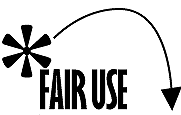
A number of factors which are considered in determining whether a
case is "fair use." In the appendix of the book, Alan Korn has a good
summary of the current law (from the 1976 Copyright Act) and case
history. Below is a brief description of the four factors. Keep in
mind that there is no set rule about the use of these factors - a case
can seem to violate one or more of the rules and can still be
considered fair use, if the case for the other factors is strong enough.
- Purpose and character of the use. Non-profit use is considered
fairer game. However, criticism, news reporting and parody can
sometimes be considered fair use, even if they are conducted for
profit.
- The nature of the copyrighted work. This includes whether the
work is published or unpublished, whether it is considered factual or
fictional, and how much creativity or work was invested to make it.
- The amount of the work used. The less you use of a work, the
easier it is to argue fair use. Also, the less similar the new work or
new use of the copyrighted material is to the original, the better.
- The effect on the market value of the copyrighted work. The
Supreme Court has stated that this is the most important factor. If
the market for the copyrighted work is diminished, this is considered
a infringement of the copyright. This does not apply to criticism of
the work (i.e., a negative review of it) - it applies to cases where the
appropriation of the work satisfies some of the demand for the
original work.
A Fair Use Test
The following cases illustrate the often-contradictory history of case
law in the copyright arena. Can you guess which cases were ruled
legal?
- 2 Live Crew releases a parody of Roy Orbison's "Oh, Pretty
Woman," substituting the lyrics with "shocking ones". Their manager
asks for permission to release the song, but the song's publisher
refuses permission. 2 Live Crew releases the song anyway, giving
credit to copyright holders.
- The Nation excerpts some short passages from President Ford's
memoirs in discussing the Nixon pardon, before the book is released.
Harper & Row, the publishers of the book, sue the Nation.
- Samsung runs an ad starring a robot in a wig, gown and jewelry
(reminiscent of Vanna White) standing next to a Wheel-of-Fortune-
like game board. White sues under a California law which gives her
the exclusive right to her name, likeness, signature and voice for
commercial purposes.
- Triangle Publications, Inc., a publisher of a TV Guide competitor,
uses the image of the TV Guide magazine cover in one of their ads.
Knight-Ridder, owners of TV Guide, sues.
(answers)
back to the review
